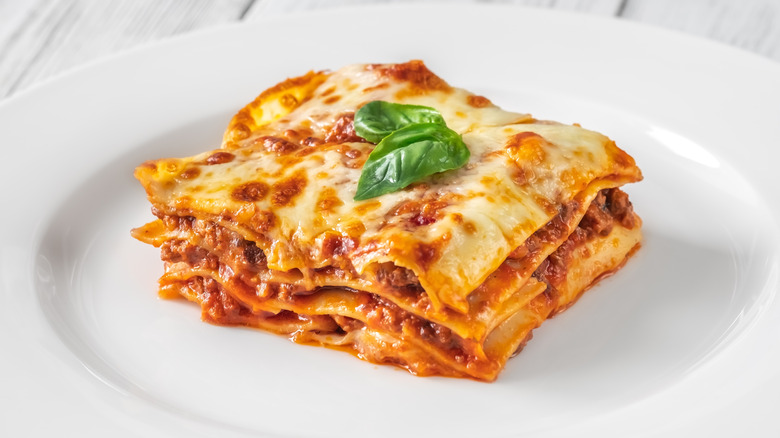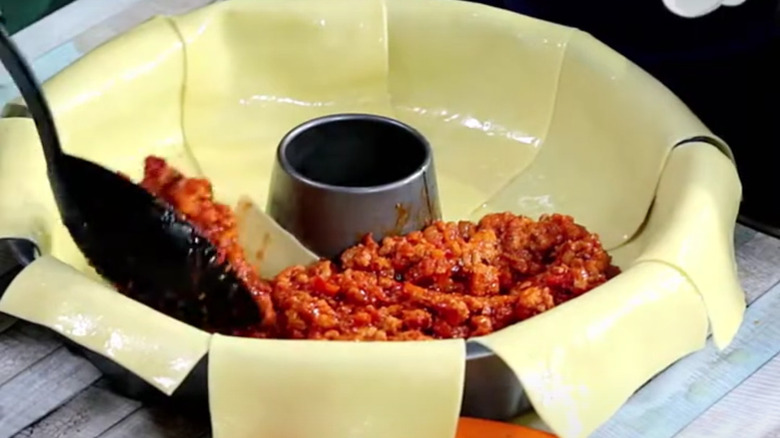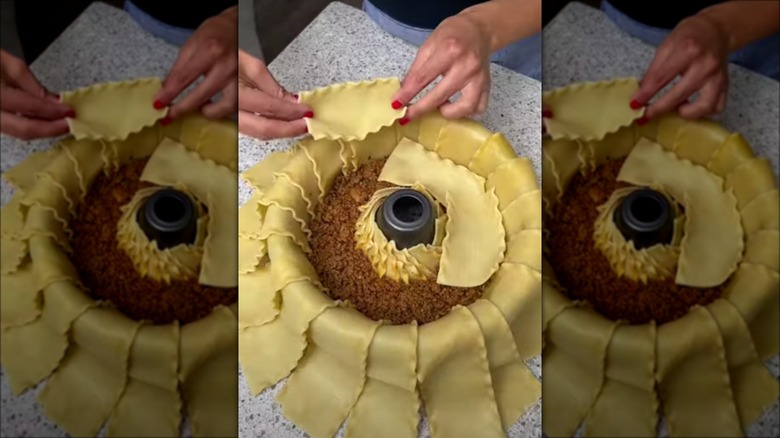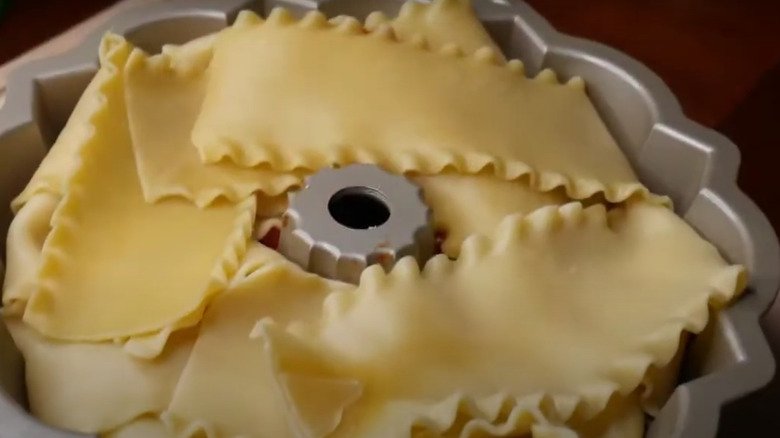The Bundt Cake Hack To Try On Your Next Lasagna
We may receive a commission on purchases made from links.
Who knew that the Bundt pan you found at a garage sale is good for more than just making your boxed cake mix look pretty. In fact, it can turn your favorite lasagna recipe into a centerpiece for the ages, the likes of which would be equally comfortable decorating the tables of kings and party planners alike. More plainly, your lasagna will takes on the shape of the Bundt pan, complete with a hole in the center, giving it an oooh-aaah factor that your rectangular-shaped lasagna doesn't have.
Naturally, you'll work with the lasagna noodles differently for this set-up than you do when you make lasagna in a square or rectangular pan. Essentially, you must figure out a way to make square noodles fit into a round hole. Fortunately, cooking the pasta sheets al dente allows you to mold and layer them until you have a lasagna that conforms to the shape of the Bundt pan.
Layering your lasagna noodles in a Bundt pan
After greasing your pan, begin building your lasagna ring by positioning the noodles in the pan so that the ends of the pasta sheets are nestled up next to the "nozzle" in the center of the pan. It isn't necessary to pull each pasta sheet all the way up the nozzle. Positioning each of them at its base works just fine.
Layer the noodles until you've essentially created a fan of pasta sheets. That is, one end of each noodle starts at the center of the Bundt pan while the opposite end hangs over the side of the pan. Fan the noodles around the whole pan using this method until the interior of the pan is covered completely.
As far as the rest of the layers of noodles go, you have a couple of options. You can either take some of your al dente lasagna pasta and cut the noodles into smaller pieces to fit. Or you can use "miniature" lasagna noodles, like Garofala's Mafalda Corta, to create the interior layers of the lasagna recipe.
In the latter case, the small pieces of pasta are shaped like lasagna noodles, but they're shorter and narrower. Their size allows you to position them almost parallel to the walls of the pan. The layers of noodles won't snuggle up neatly against the side of the pan, an issue that you'll remedy later when you fold the ends of the large noodles over the top of the dish.
Prepping your other ingredients
Some traditional lasagna recipes call for raw ingredients, allowing you to start with uncooked noodles, raw ground beef or turkey, unmelted cheese, and raw vegetables. Through the standard baking process, be assured that those ingredients, including the dry noodles, will cook in the oven until they're done. However, due to the fact that you're using pre-cooked pasta for this dish, you'll also want to cook the rest of the ingredients, too. If you don't, you'll end up with parts of the lasagna pie that are raw.
To prepare your lasagna filling, sauté ingredients like onions, garlic, and carrots, and other aromatics in a separate pan. You'll do the same for the meat and any veggies that need to be softened by cooking, like eggplant or bell peppers. They don't have to be cooked completely, as some of the cooking happens in the oven. You just want to give them a head start.
Next, you'll add these cooked ingredients to the Bundt pan. Separate each layer — meat, ricotta or mozzarella cheeses, vegetables, tomato or béchamel sauce — with some cooked noodles, just as you would if you were making lasagna in a rectangular pan. At this juncture, you're not doing anything with the fanned noodles that are hanging over the edges of the Bundt pan. Leave that task until the end.
Finishing your pasta dish
Once you've placed your last layer of pasta sheets, fold the ends of the fanned noodles over them until they touch the center nozzle. Wrap each noodle like this until the whole top of the lasagna pie is covered by cooked noodles. Bake the pasta ring in the Bundt pan for 45 to 50 minutes. Once it comes out of the oven, let it hang out on the counter for up to an hour. This gives the ingredients additional time to set.
When it's finally ready to serve, place a plate that's slightly larger than the pan over it and flip the whole thing over. The lasagna ring should slide out in one piece, like a Bundt cake would, if you greased the pan beforehand. If you're nervous about whether or not this will work, try cooking it in a silicone pan, like Silivo's 7-inch bakeware. These pans are often soft and pliable, making it easier for you to twist and turn their edges until the lasagna releases its grip on the pan's sides and comes out. Otherwise, a standard Bundt pan, like Nordic Ware's original design, will work.
Garnish your lasagna with sprinkles of grated cheese, bits of parsley, a pinch of salt, and a drizzle of your sauce of choice. The final touch — a small bowl of marinara sauce placed in the center of the ring — makes the dish dip-worthy, delicious, and ready for a party.



